Heat Transfer Enhancement of the Air-Cooling Tower with Rotating Wind Deflectors under Crosswind Conditions
Abstract
:Featured Application
Abstract
1. Introduction
2. Experimental Procedure and Data Reduction
2.1. Experimental System and Procedure
2.2. Data Reduction
2.2.1. Cooling Temperature Drop
2.2.2. Heat Dissipating Capacity
2.2.3. Thermal Efficiency Coefficient
2.2.4. Dimensionless Velocity
3. Numerical Model
3.1. Governing Equations
3.2. Model Geometry
3.3. Boundary Conditions
3.4. Solver and Mesh
3.5. Grid Independence and Model Validation
4. Results and Discussion
4.1. The Effect of Crosswind on Cooling Performance
4.2. Effect of Crosswind on Performance with Wind Deflectors
4.3. Effect of Crosswind on Performance with Rotating Wind Deflectors
5. Conclusions
Acknowledgments
Author Contributions
Conflicts of Interest
Nomenclature
| A | Heat transfer area, [m2] |
| cp | Specific heat at constant pressure, [J∙kg−1∙K−1] |
| Fr | Froude number |
| k | Overall heat transfer coefficient, [W∙m−2∙K−1] |
| Pr | Prandlt number of the fluid |
| qw | Volume flow rate of the cooling water, [m3∙s−1] |
| Q | Heat dissipating capacity, [W] |
| T | Temperature, [K] |
| v | Wind velocity, [m∙s−1] |
| V | Dimensionless velocity |
| Greek symbols | |
| Thermal efficiency coefficient | |
| Temperature difference, [K] | |
| λ | Coefficient of heat conductivity, [W∙m−1∙K−1] |
| ρ | Density, [kg∙m−3] |
| Subscripts | |
| 0 | No crosswind |
| a | Air |
| i | Inlet |
| max | Maximum value |
| min | Minimum value |
| o | Outlet |
| v | Crosswind with a certain velocity |
| w | Water |
References
- Klein, S.; Beckman, W.; Mitchell, J.; Duffie, J.; Duffie, N.; Freeman, T.; Mitchell, J.; Braun, J.; Evans, B.; Kummer, J. TRNSYS 16. A TRaNsient SYstem Simulation Program; Mathematical Reference; Energy Laboratory, University of Wisconsin-Madison: Madison, WI, USA, 2004; Volume 5. [Google Scholar]
- Cutillas, C.G.; Ramírez, J.R.; Miralles, M.L. Optimum design and operation of an HVAC cooling tower for energy and water conservation. Energies 2017, 10, 299. [Google Scholar] [CrossRef]
- Wang, Q.W.; Zeng, M.; Ma, T.; Du, X.P.; Yang, J.F. Recent development and application of several high-efficiency surface heat exchangers for energy conversion and utilization. Appl. Energy 2014, 35, 748–777. [Google Scholar] [CrossRef]
- Du, X.P.; Yin, Y.T.; Zeng, M.; Yu, P.Q.; Wang, Q.W.; Dong, Z.Y.; Chen, Y.T. An experimental investigation on air-side performances of finned tube heat exchangers for indirect air-cooling tower. Therm. Sci. 2014, 18, 863–874. [Google Scholar] [CrossRef]
- Gao, M.; Guo, C.; Ma, C.; Shi, Y.; Sun, F. Thermal performance for wet cooling tower with different layout patterns of fillings under typical crosswind conditions. Energies 2017, 10, 65. [Google Scholar] [CrossRef]
- Su, M.D.; Tang, G.F.; Fu, S. Numerical simulation of fluid flow and thermal performance of a dry-cooling tower under cross wind condition. J. Wind Eng. Ind. Aerodyn. 1999, 79, 289–306. [Google Scholar] [CrossRef]
- Zhao, Y.; Sun, F.; Li, Y.; Long, G.; Yang, Z. Numerical study on the cooling performance of natural draft dry cooling tower with vertical delta radiators under constant heat load. Appl. Energy 2015, 149, 225–237. [Google Scholar] [CrossRef]
- Kapas, N. Behavior of natural draught cooling towers in wind. In Proceedings of the 4th International Conference on Fluid Flow Technologies, Budapest, Hungary, 3–6 September 2003. [Google Scholar]
- Chen, Y.; Sun, F.; Gao, M.; Zhao, Y.; Shi, Y. Experimental study of cross walls effect on the performance of wet cooling towers. Proc. CSEE 2012, 32, 28–34. [Google Scholar]
- Preez, A.F.D.; Kröger, D.G. Effect of wind on performance of a dry-cooling tower. Heat Recovery Syst. CHP 1993, 13, 139–146. [Google Scholar] [CrossRef]
- Zhai, Z.; Fu, S. Improving cooling efficiency of dry-cooling towers under cross-wind conditions by using wind-break methods. Appl. Therm. Eng. 2006, 26, 1008–1017. [Google Scholar] [CrossRef]
- Wang, K. Research on Flow Resistance of Inlet Air Performance Optimization of Natural Draft Counter Flow Wet Cooling Tower with Air Deflectors; Shandong University: Jinan, China, 2009. [Google Scholar]
- Goodarzi, M. A proposed stack configuration for dry cooling tower to improve cooling efficiency under crosswind. J. Wind Eng. Ind. Aerodyn. 2010, 98, 858–863. [Google Scholar] [CrossRef]
- Lu, Y.; Guan, Z.; Gurgenci, H.; Zou, Z. Windbreak walls reverse the negative effect of crosswind in short natural draft dry cooling towers into a performance enhancement. Int. J. Heat Mass Transf. 2013, 63, 162–170. [Google Scholar] [CrossRef]
- Du, X.; Hu, H.; Shen, Y.; Yang, L.; Yang, Y. Reduced order analysis of flow and heat transfer for air-cooled condenser of power generating unit. Appl. Therm. Eng. 2013, 51, 383–392. [Google Scholar] [CrossRef]
- Du, X.P.; Zeng, M.; Dong, Z.Y.; Wang, Q.W. Experimental study of the effect of air inlet angle on the air-side performance for cross-flow finned oval-tube heat exchangers. Exp. Therm. Fluid Sci. 2014, 52, 146–155. [Google Scholar] [CrossRef]
- Du, X.P.; Zeng, M.; Wang, Q.W.; Dong, Z. Experimental investigation of heat transfer and resistance characteristics of a finned oval-tube heat exchanger with different air inlet angles. Heat Transf. Eng. 2014, 35, 703–710. [Google Scholar] [CrossRef]
- Huang, J.; Liu, M.; Jin, T. A comprehensive empirical correlation for finned heat exchangers with parallel plates working in oscillating flow. Appl. Sci. 2017, 7, 117. [Google Scholar] [CrossRef]
- Liu, Z.Y.; Varbanov, P.S.; Klemeš, J.J.; Yong, J.Y. Recent developments in applied thermal engineering: Process integration, heat exchangers, enhanced heat transfer, solar thermal energy, combustion and high temperature processes and thermal process modelling. Appl. Therm. Eng. 2016, 105, 755–762. [Google Scholar] [CrossRef]
- Liang, C.; Tong, X.; Lei, T.; Li, Z.; Wu, G. Optimal design of an air-to-air heat exchanger with cross-corrugated triangular ducts by using a particle swarm optimization algorithm. Appl. Sci. 2017, 7, 554. [Google Scholar] [CrossRef]
- Hooman, K.; Huang, X.; Jiang, F. Solar-enhanced air-cooled heat exchangers for geothermal power plants. Energies 2017, 10, 1676. [Google Scholar] [CrossRef]
- Chen, Y.; Sun, F.; Wang, H.; Mu, N.; Gao, M. Experimental research of the cross walls effect on the thermal performance of wet cooling towers under crosswind conditions. Appl. Therm. Eng. 2011, 31, 4007–4013. [Google Scholar] [CrossRef]
- Chen, L.; Yang, L.; Du, X.; Yang, Y. Performance improvement of natural draft dry cooling system by interior and exterior windbreaker configurations. Int. J. Heat Mass Transf. 2016, 96, 42–63. [Google Scholar] [CrossRef]
- Naik, B.K.; Muthukumar, P. A novel approach for performance assessment of mechanical draft wet cooling towers. Appl. Therm. Eng. 2017, 121, 14–26. [Google Scholar] [CrossRef]
- Wang, W.; Chen, L.; Huang, X.; Yang, L.; Du, X. Performance recovery of natural draft dry cooling systems by combined air leading strategies. Energies 2017, 10, 2166. [Google Scholar] [CrossRef]
- Takata, K.; Michioka, T.; Kurose, R. Prediction of a visible plume from a dry and wet combined cooling tower and its mechanism of abatement. Atmosphere 2016, 7, 59. [Google Scholar] [CrossRef]
- Gao, M.; Sun, F.Z.; Wang, K.; Shi, Y.T.; Zhao, Y.B. Experimental research of heat transfer performance on natural draft counter flow wet cooling tower under cross-wind conditions. Int. J. Therm. Sci. 2008, 47, 935–941. [Google Scholar] [CrossRef]
- Lu, Y.; Guan, Z.; Gurgenci, H.; Hooman, K.; He, S.; Bharathan, D. Experimental study of crosswind effects on the performance of small cylindrical natural draft dry cooling towers. Energy Convers. Manag. 2015, 91, 238–248. [Google Scholar] [CrossRef]
- Kline, S.J.; McClintock, F.A. Describing uncertainties in single-sample experiments. Mech. Eng. 1953, 75, 3–8. [Google Scholar]
- Gong, T. Experimental Research and Numerical Simulation of Crosswind Effect on the Performance of Indirect Air Cooling Tower; Shandong University: Jinan, China, 2012. [Google Scholar]
- Patankar, S.V. Numerical Heat Transfer and Fluid Flow; Hemisphere Publishing Corporation: New York, NY, USA, 1980. [Google Scholar]
- Al-Waked, R.; Behnia, M. CFD simulation of wet cooling towers. Appl. Therm. Eng. 2006, 26, 382–395. [Google Scholar] [CrossRef]
- Yang, L.J.; Wu, X.P.; Du, X.Z.; Yang, Y.P. Dimensional characteristics of wind effects on the performance of indirect dry cooling system with vertically arranged heat exchanger bundles. Int. J. Heat Mass Transf. 2013, 67, 853–866. [Google Scholar] [CrossRef]
- Zhao, Y.; Long, G.; Sun, F.; Yan, L.; Zhang, C. Numerical study on the cooling performance of dry cooling tower with vertical two-pass column radiators under crosswind. Appl. Therm. Eng. 2014, 75, 1106–1117. [Google Scholar] [CrossRef]
- Al-Waked, R. Crosswinds effect on the performance of natural draft wet cooling towers. Int. J. Therm. Sci. 2010, 49, 218–224. [Google Scholar] [CrossRef]
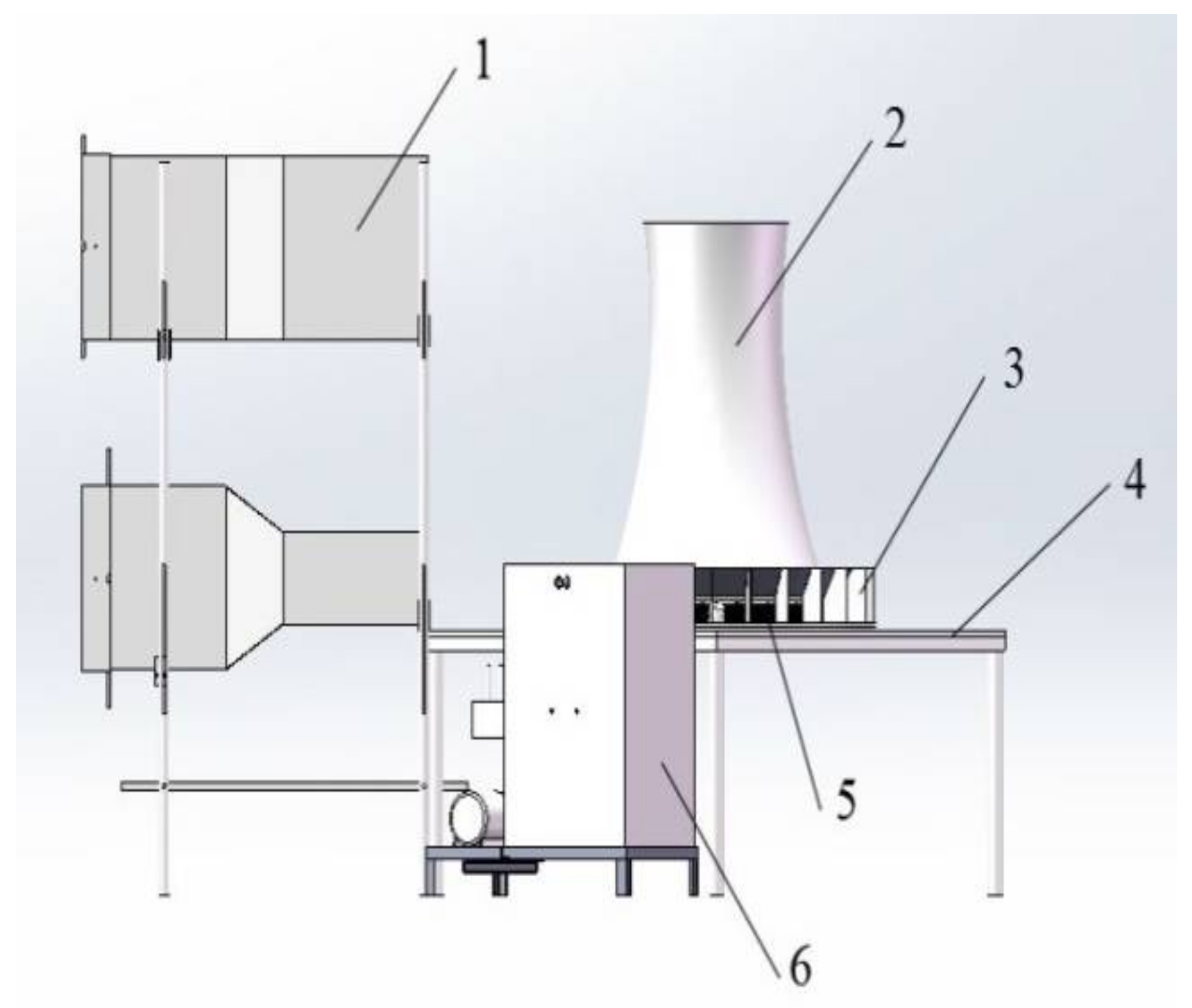
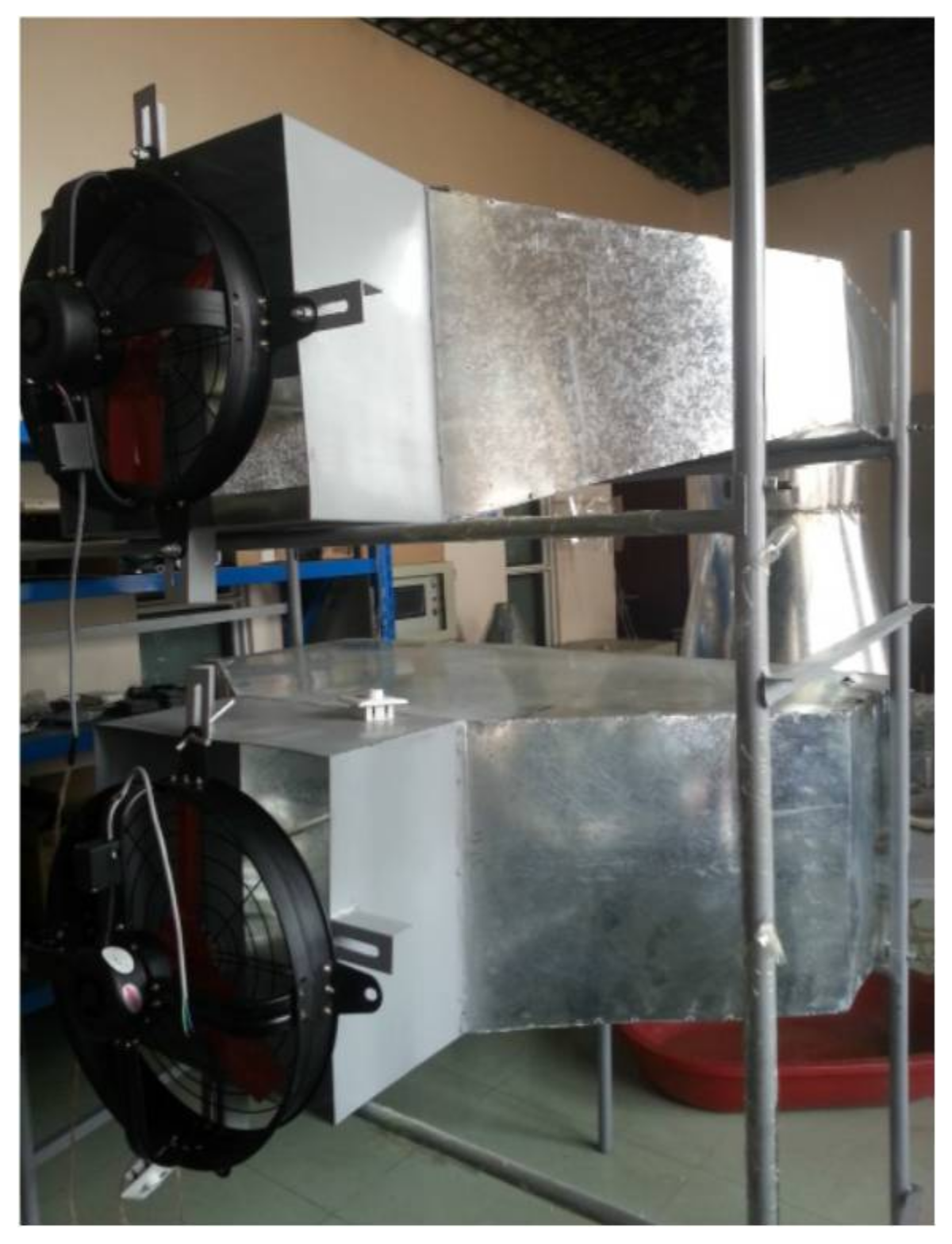
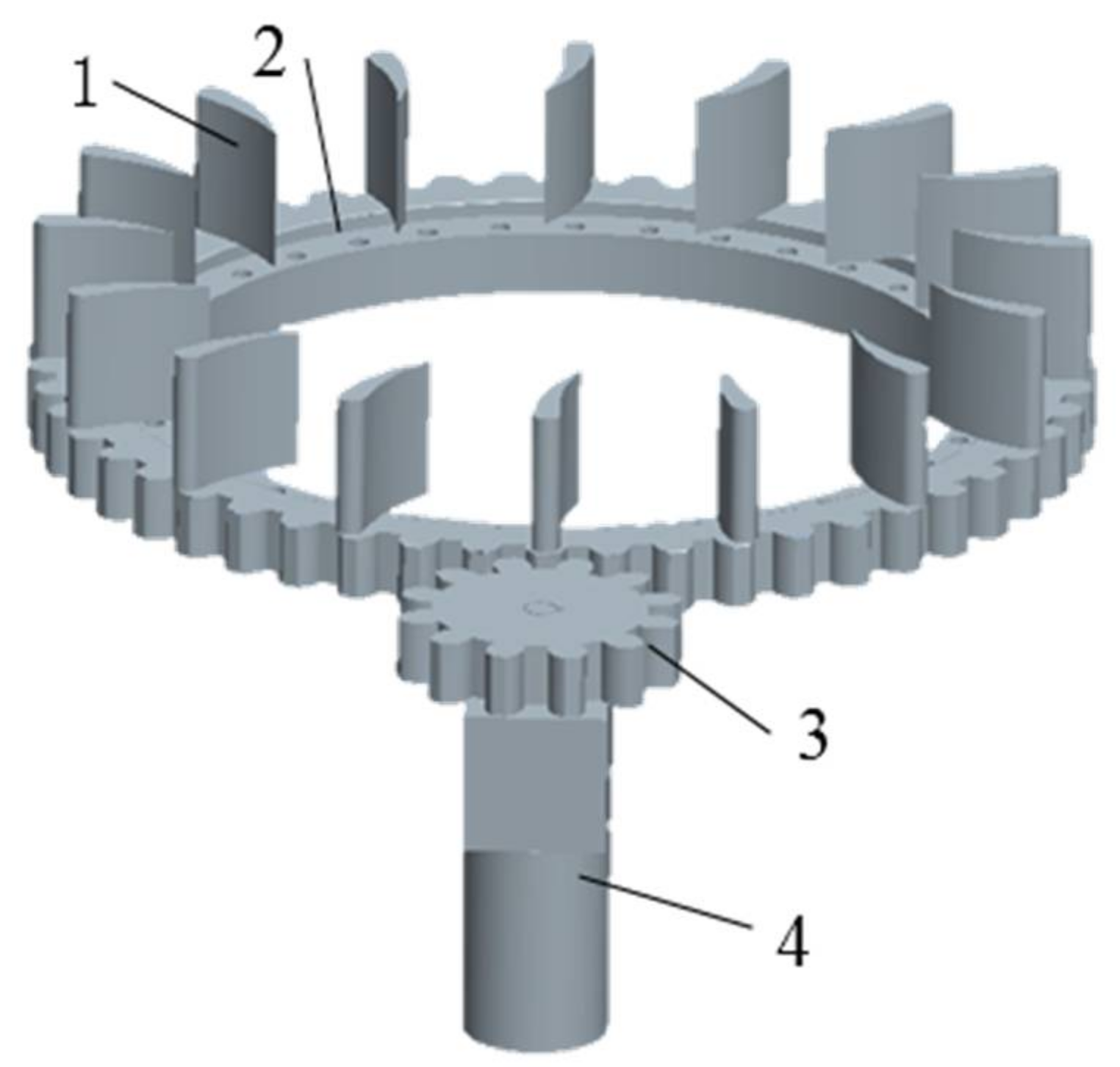

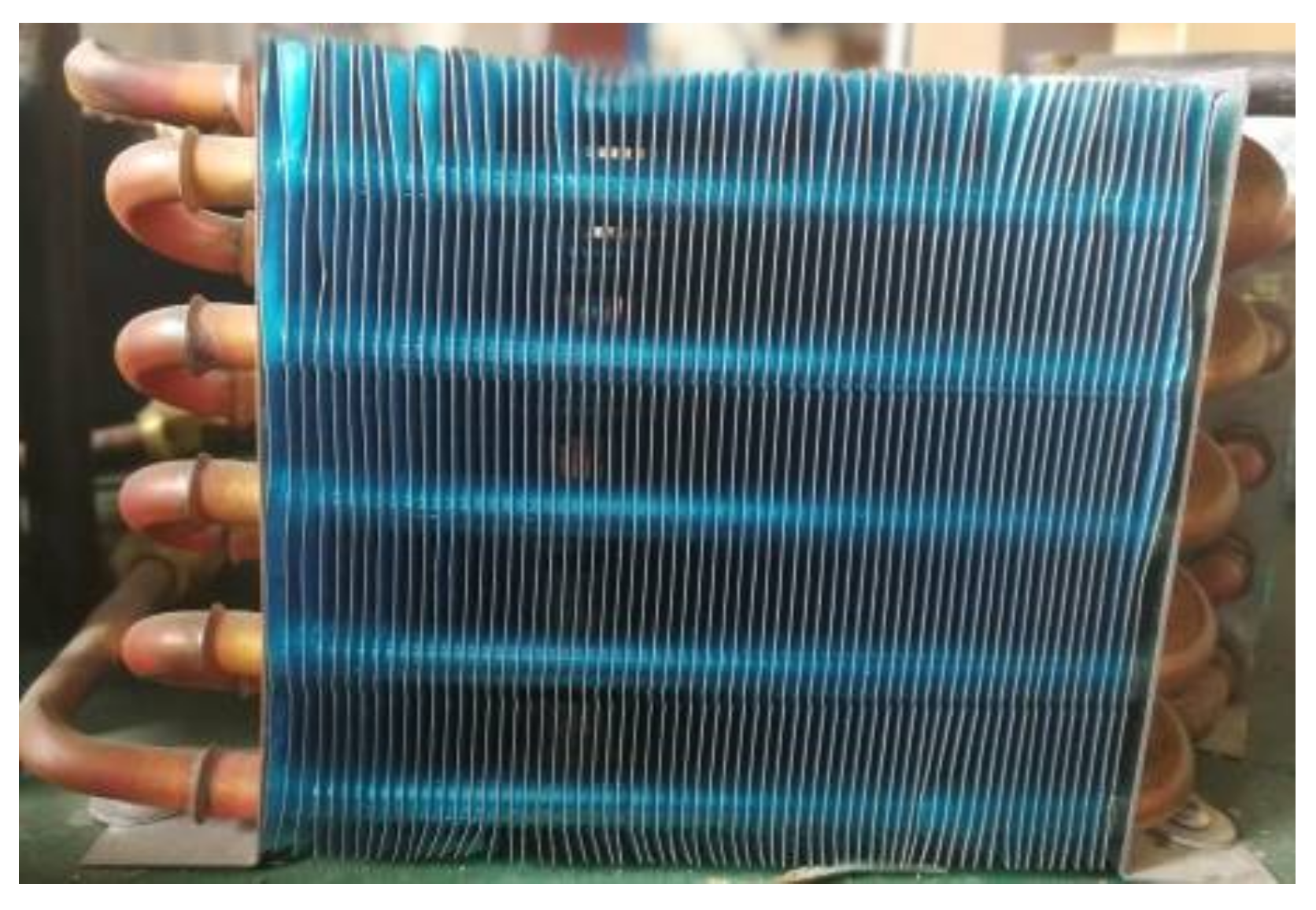
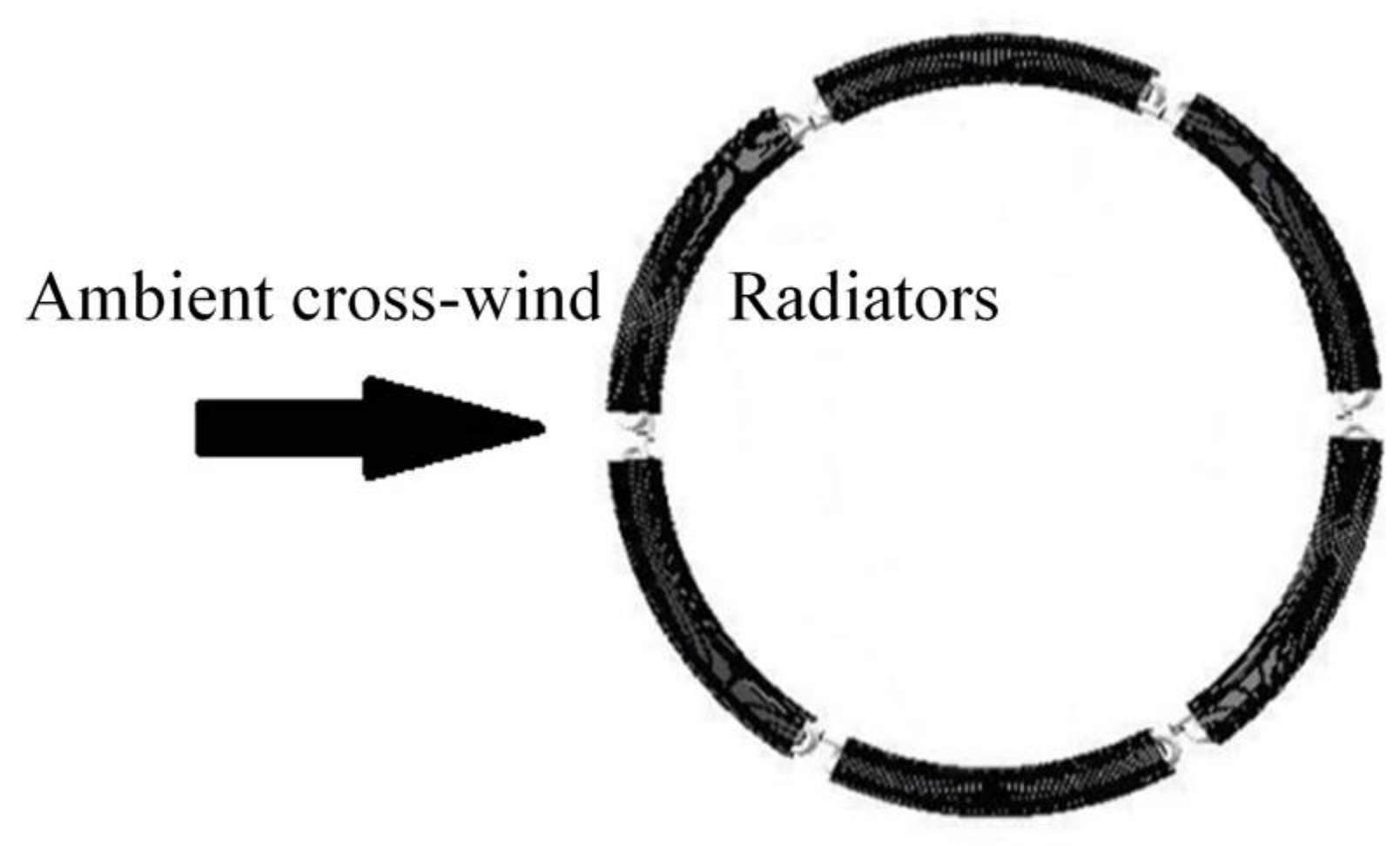
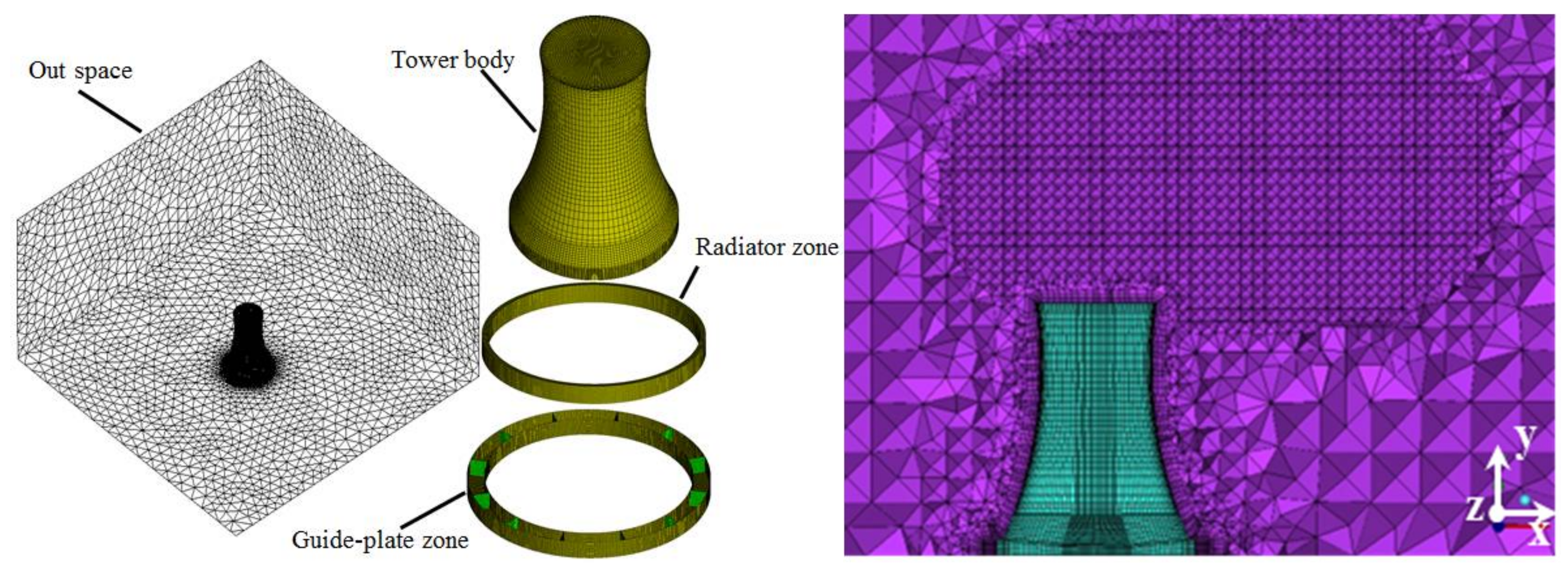
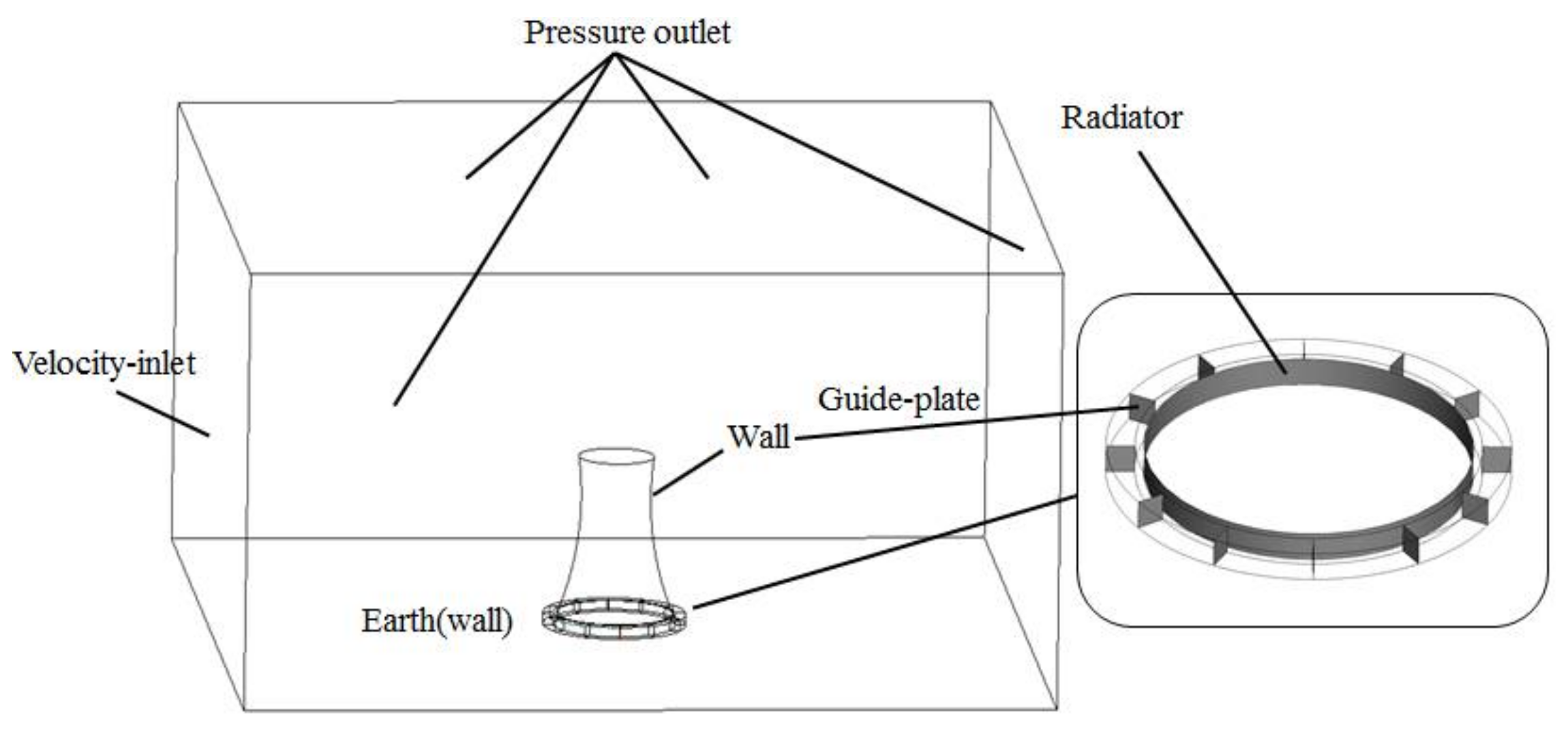
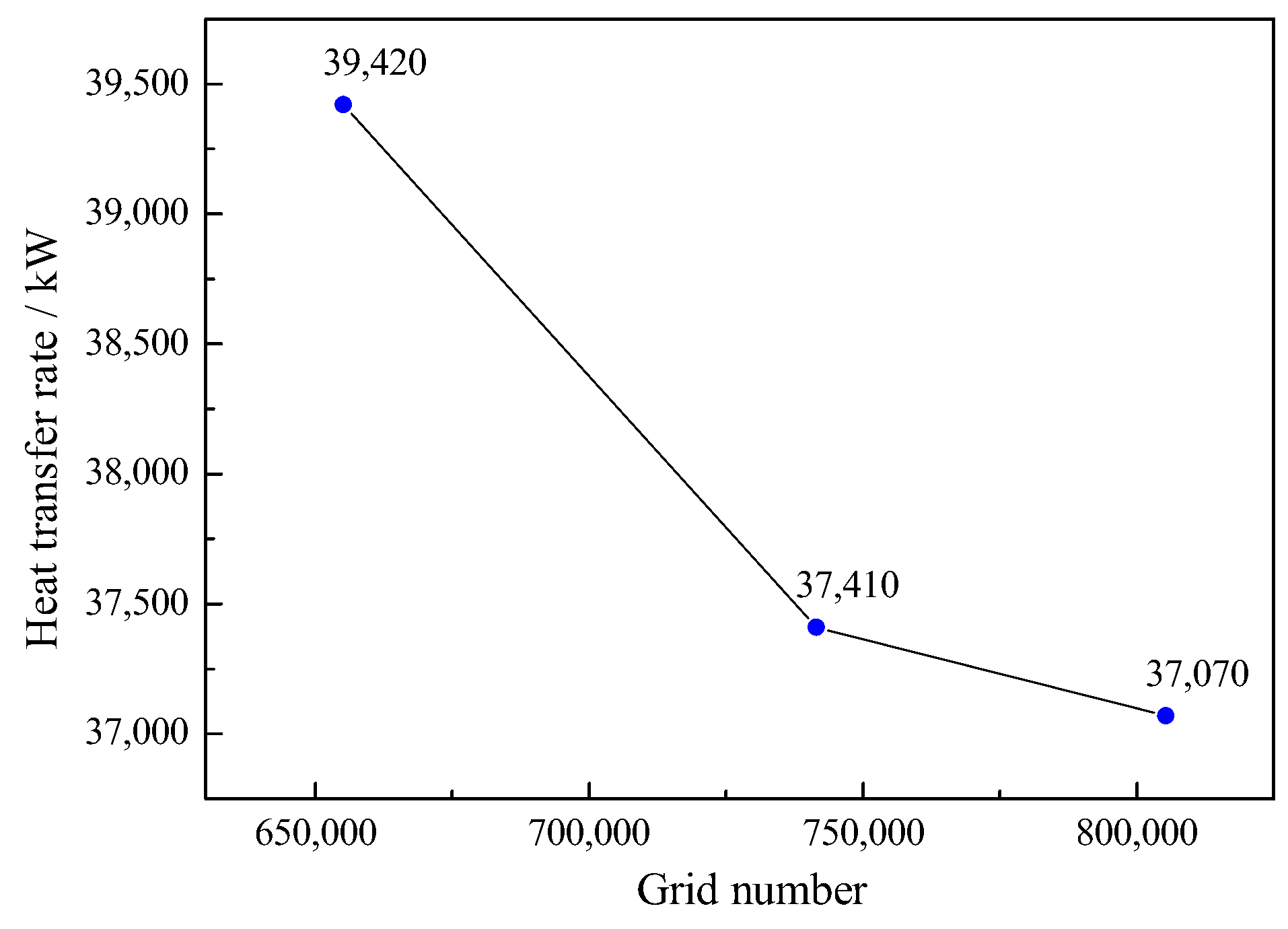
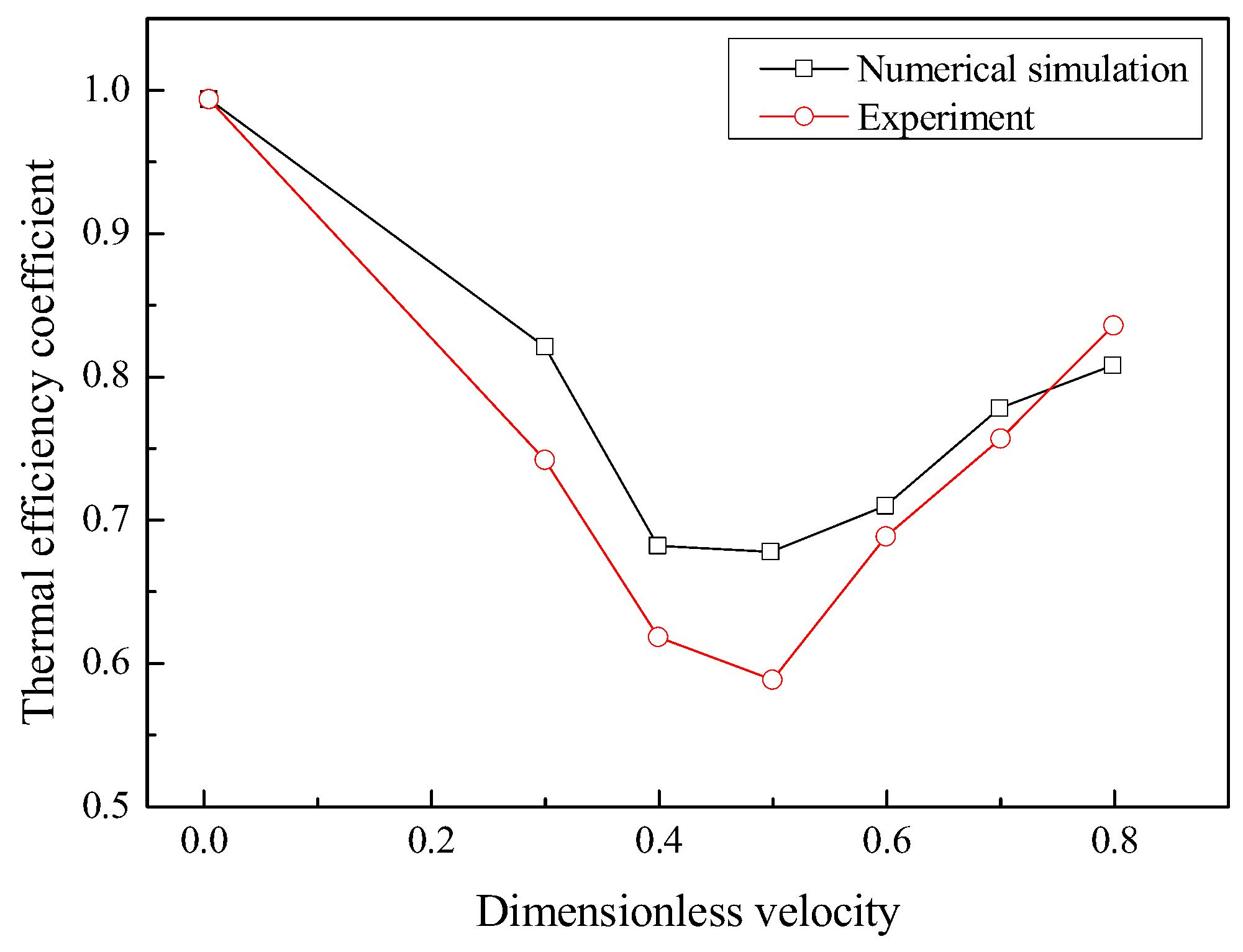
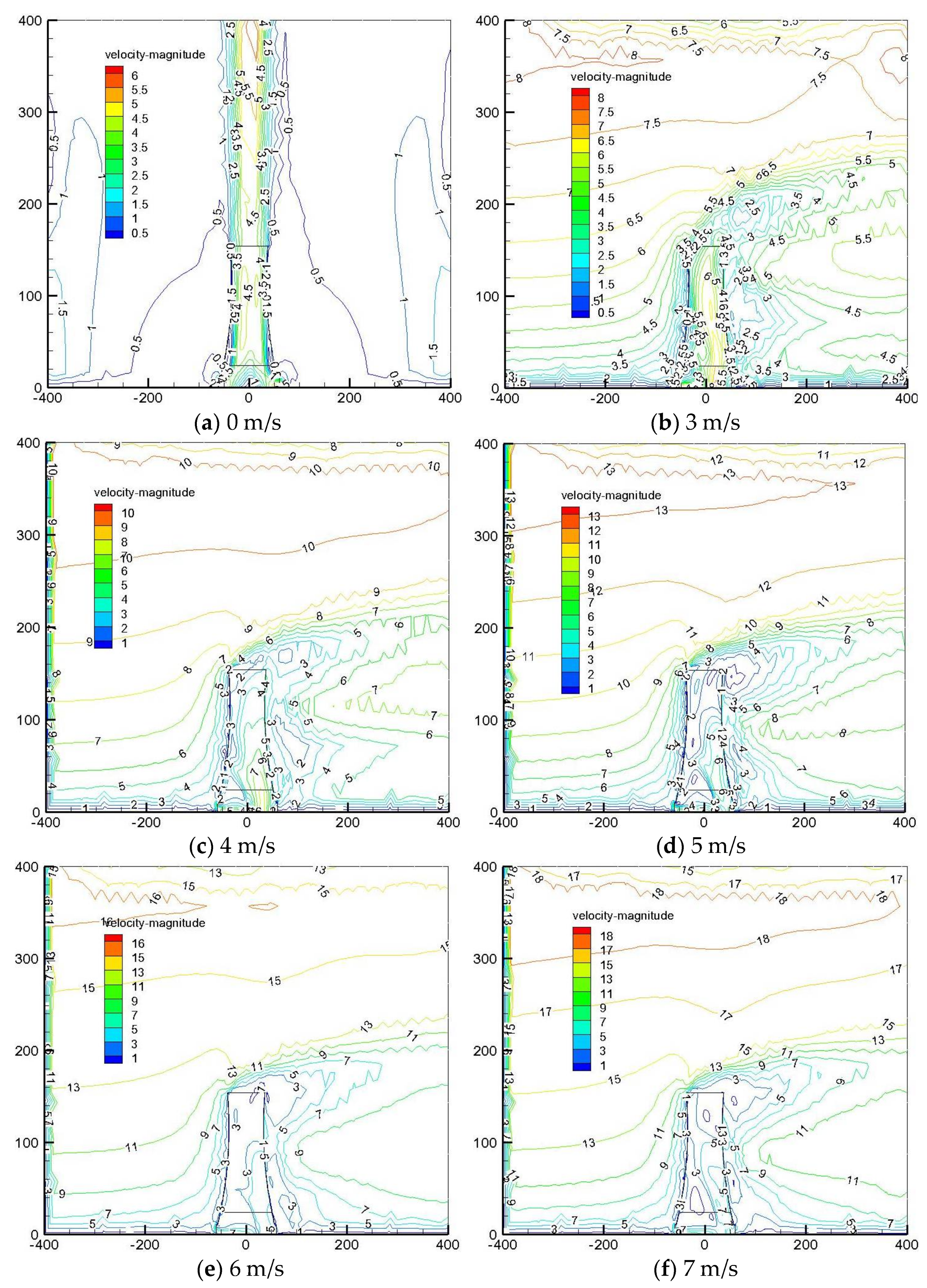
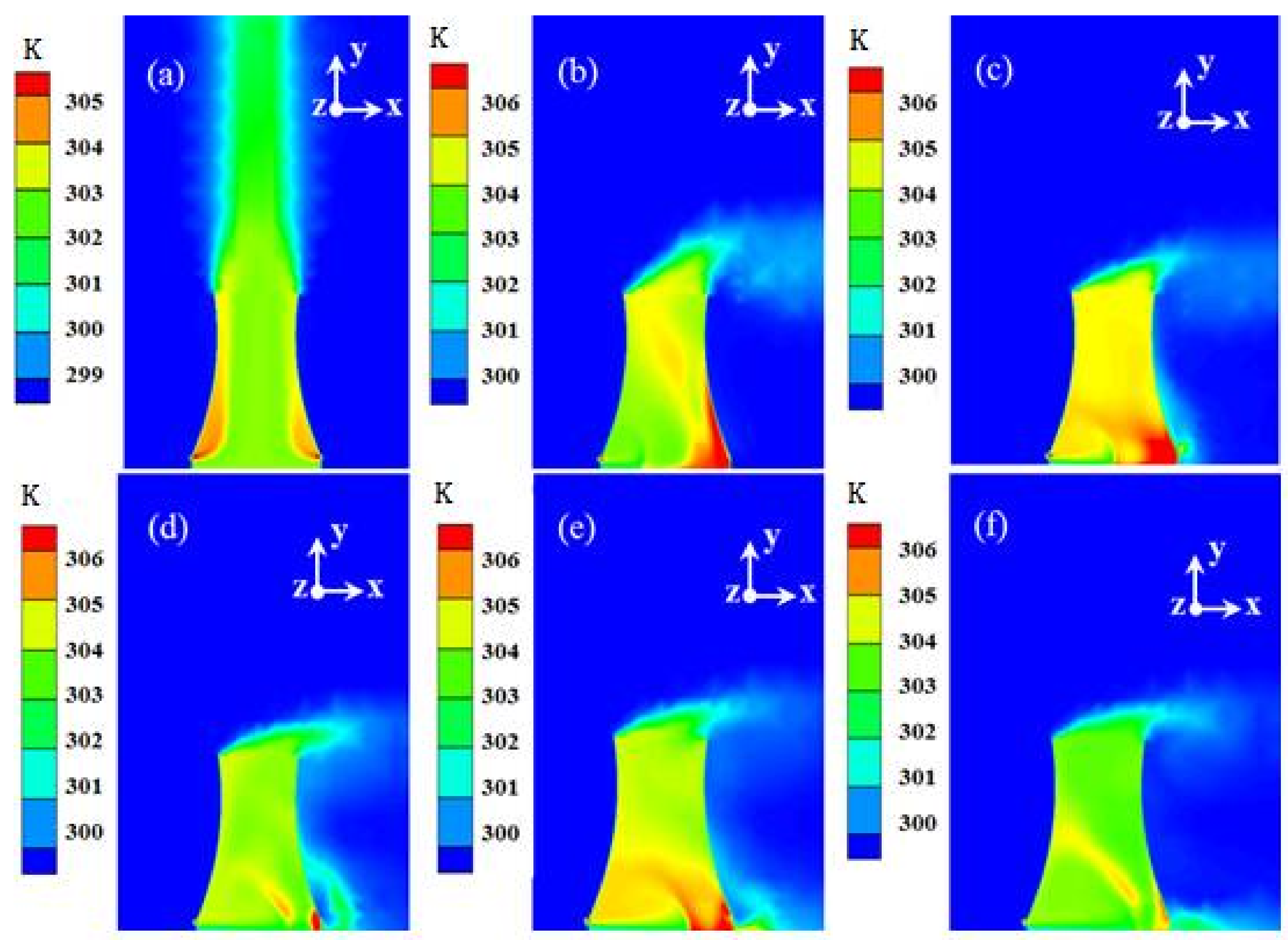
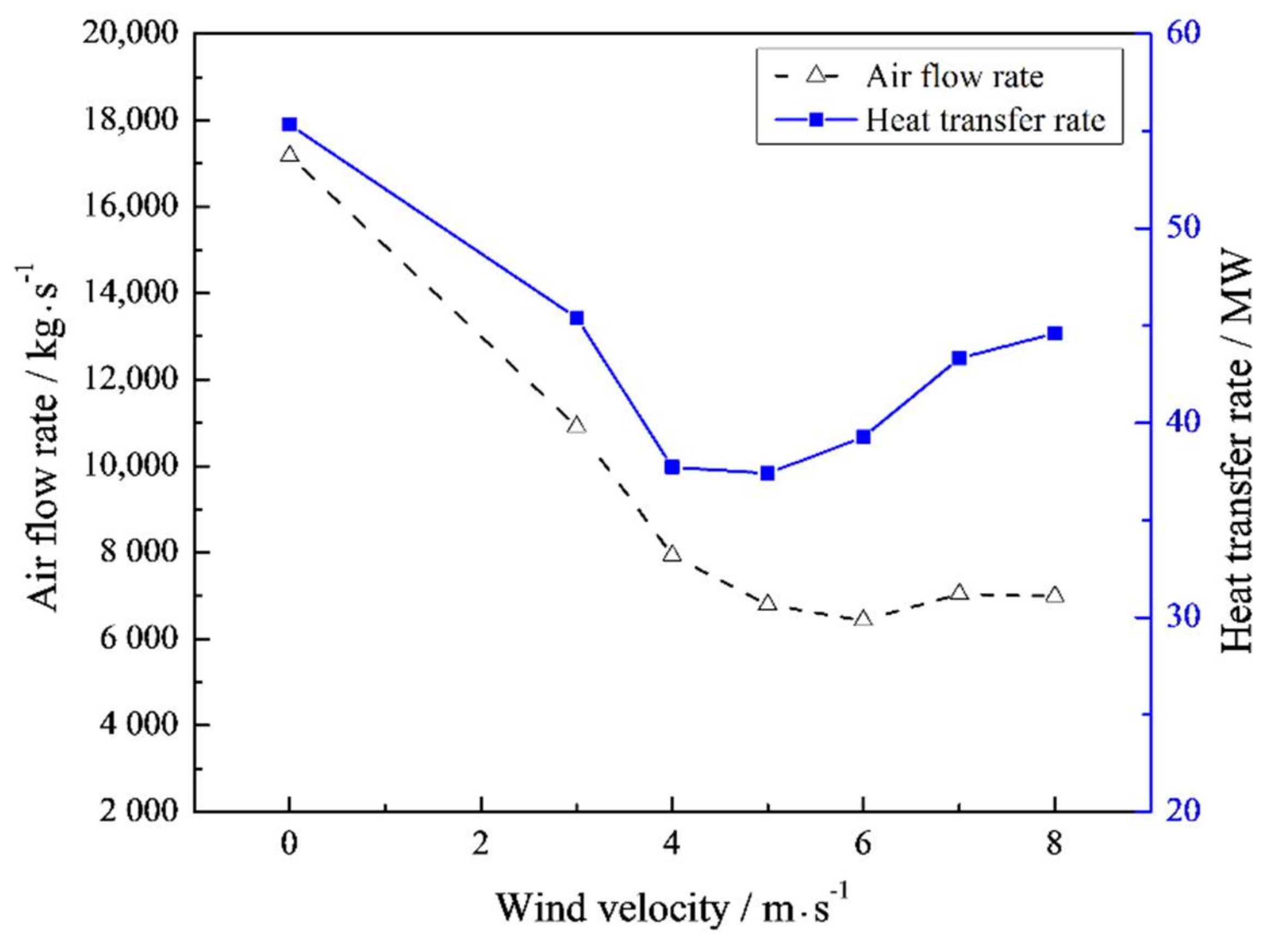
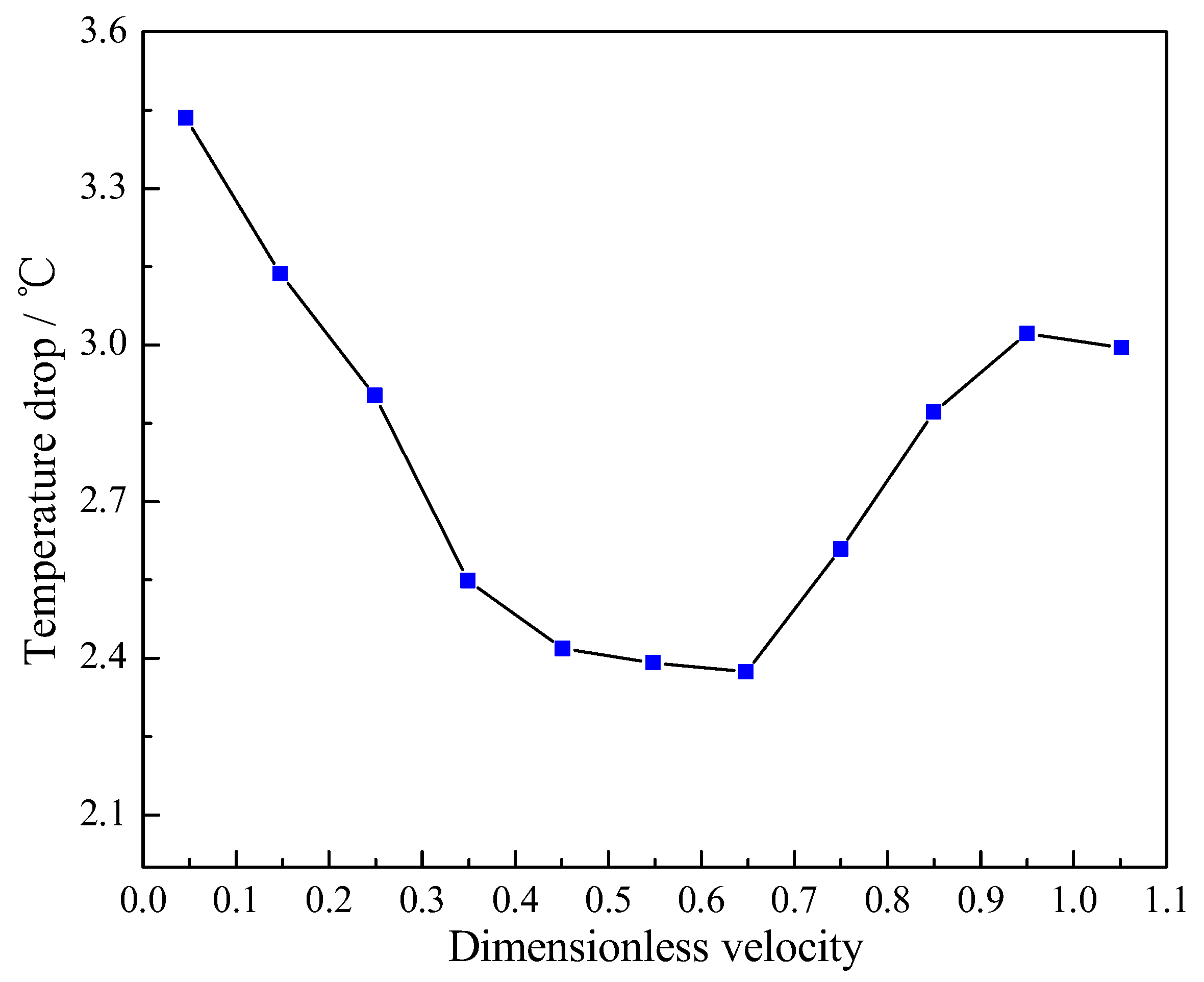
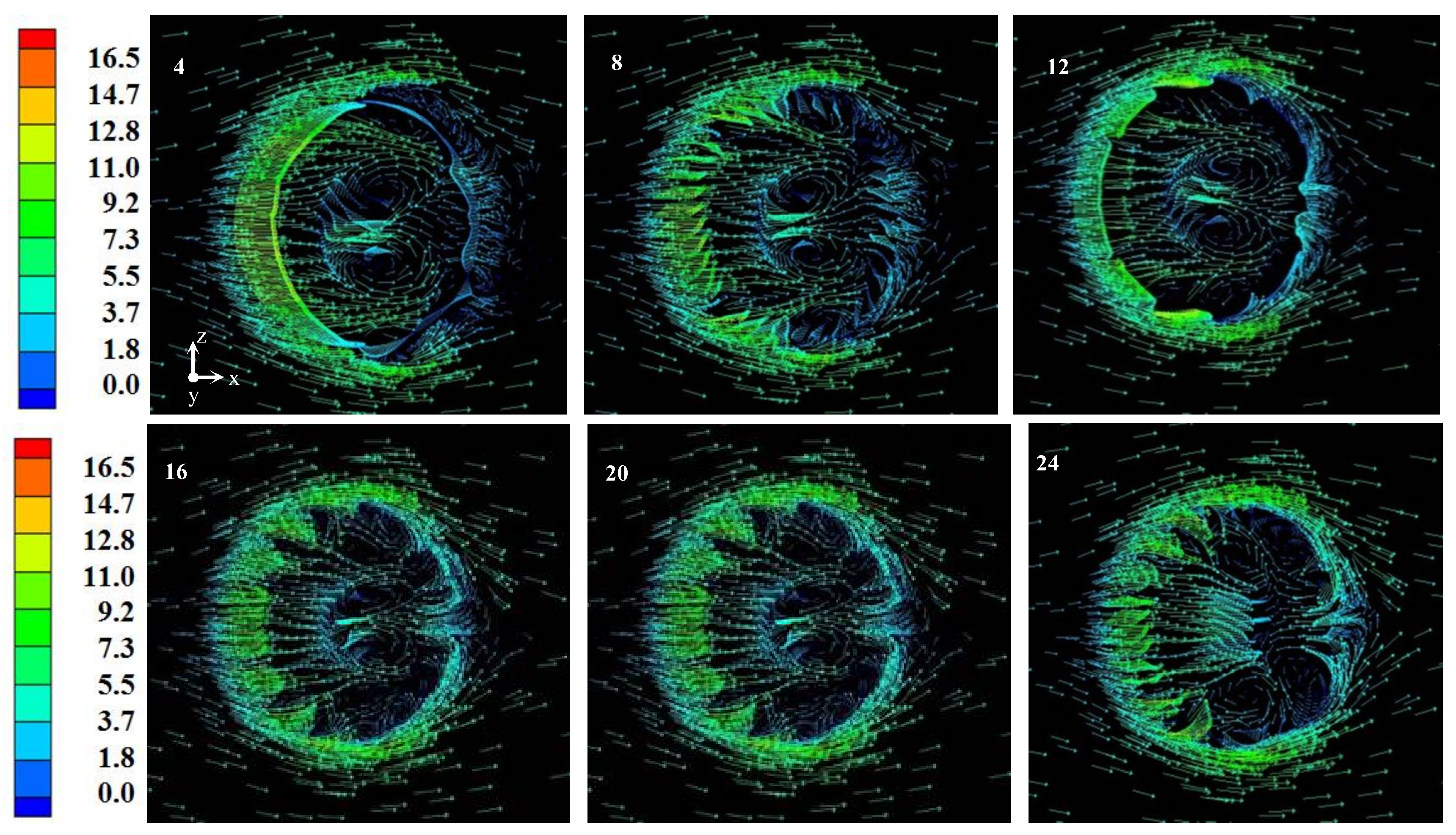
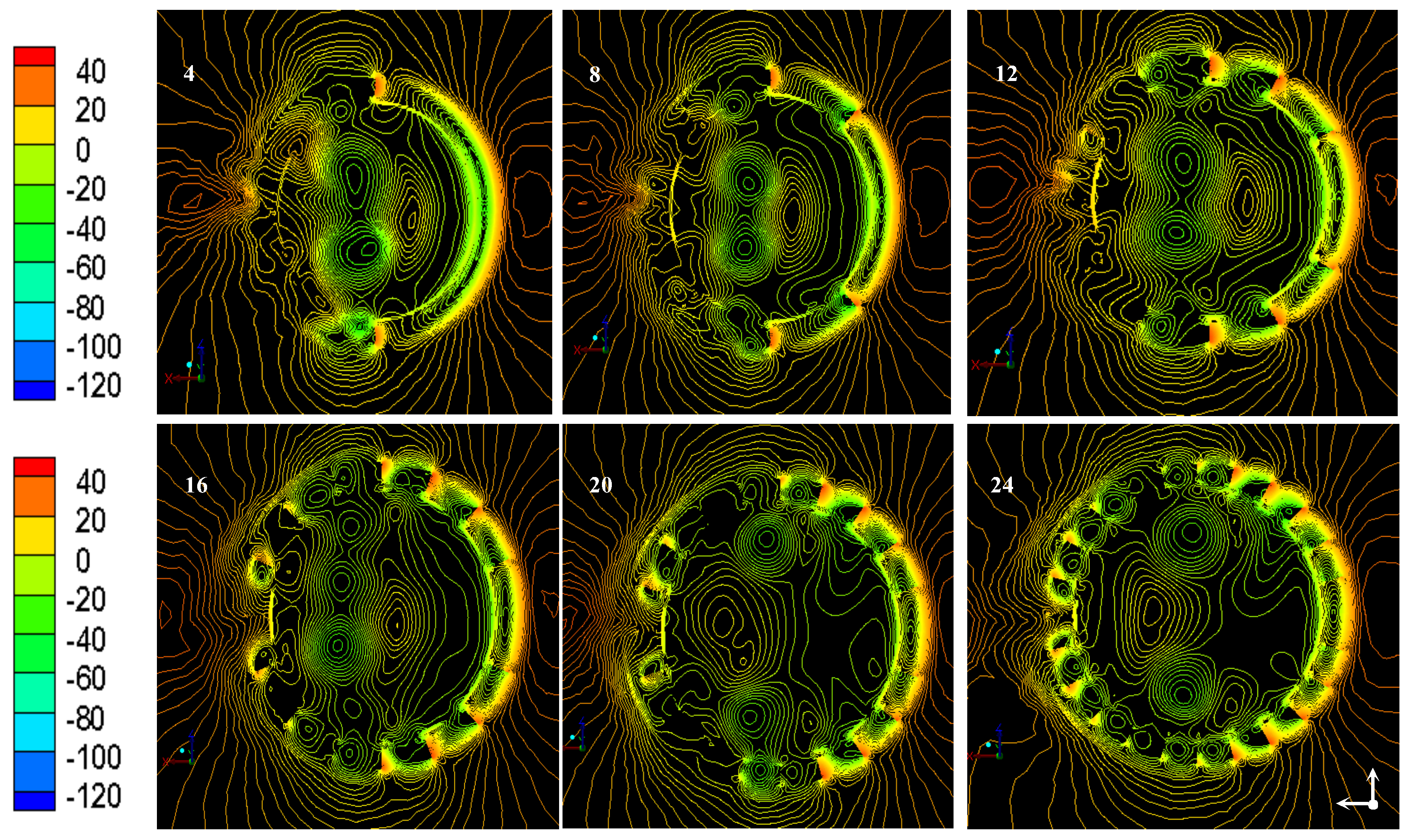

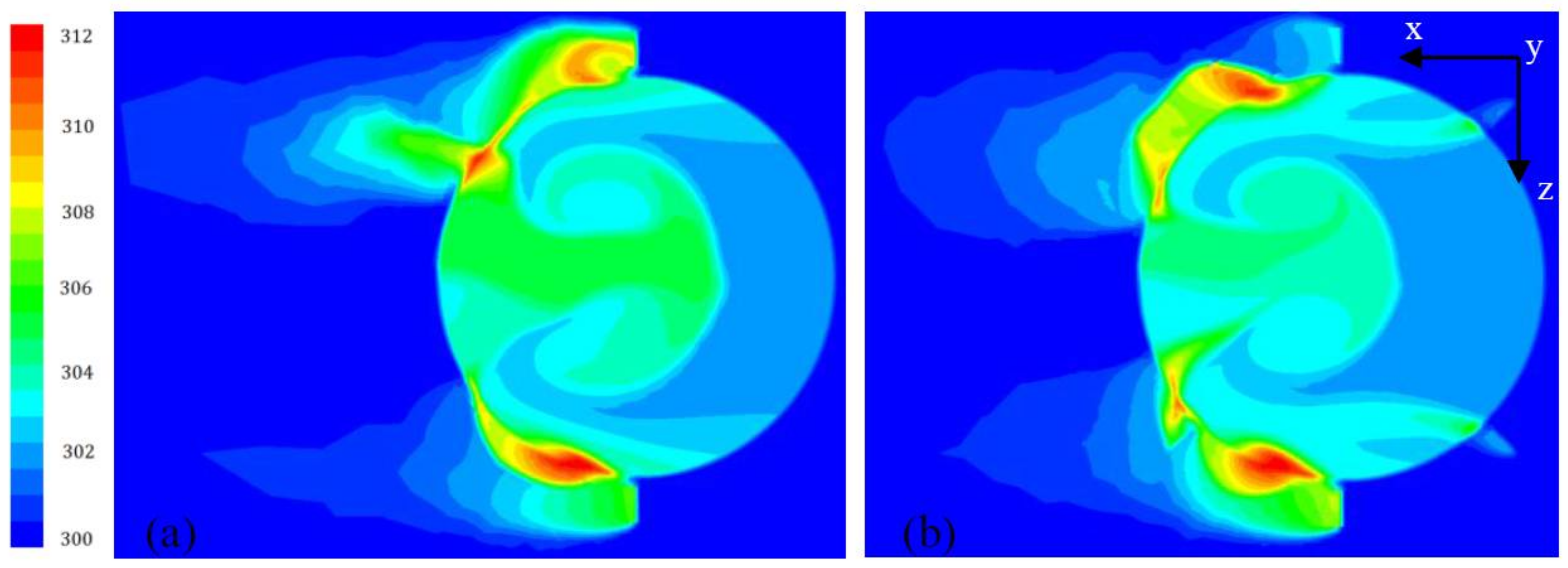
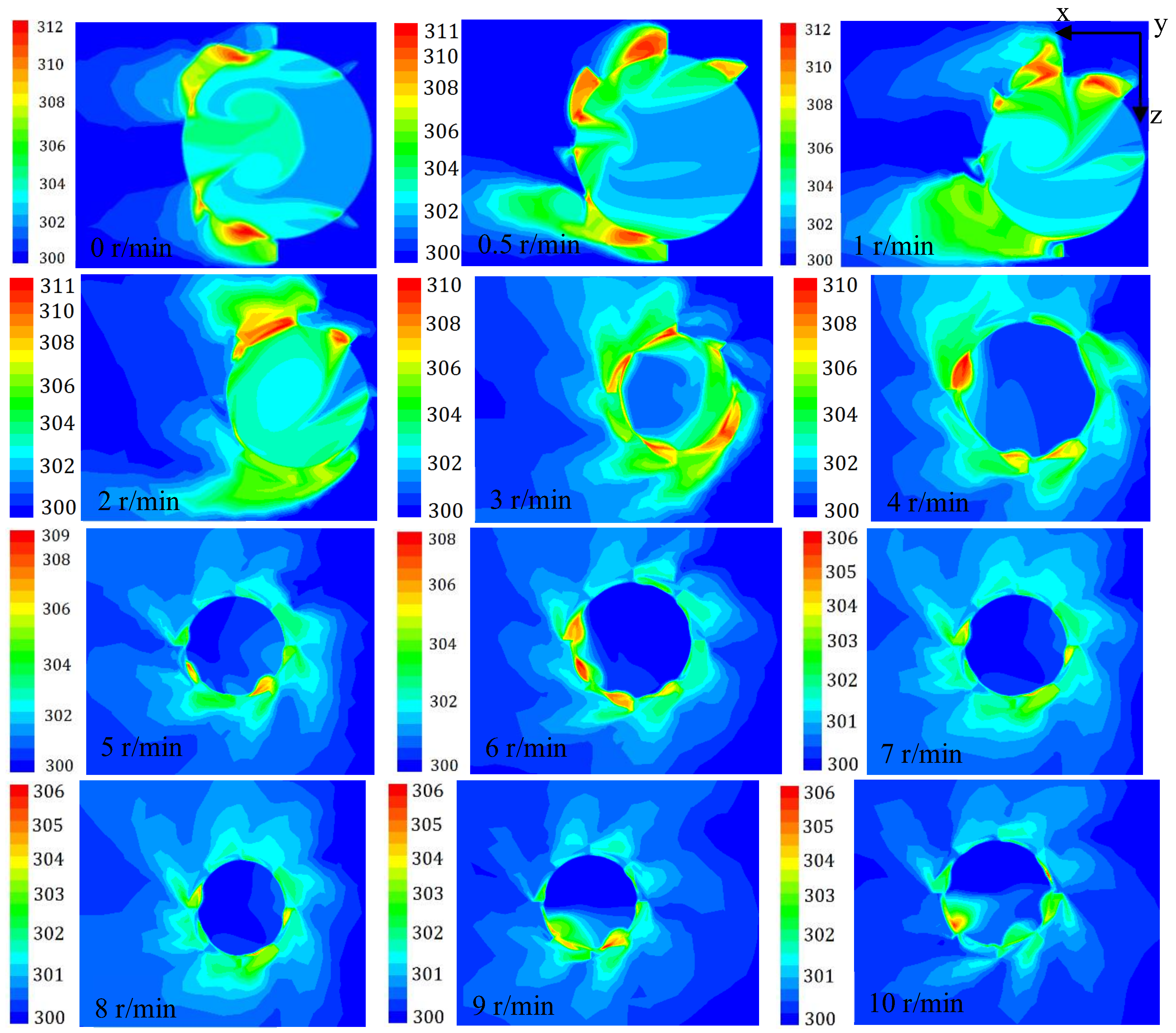
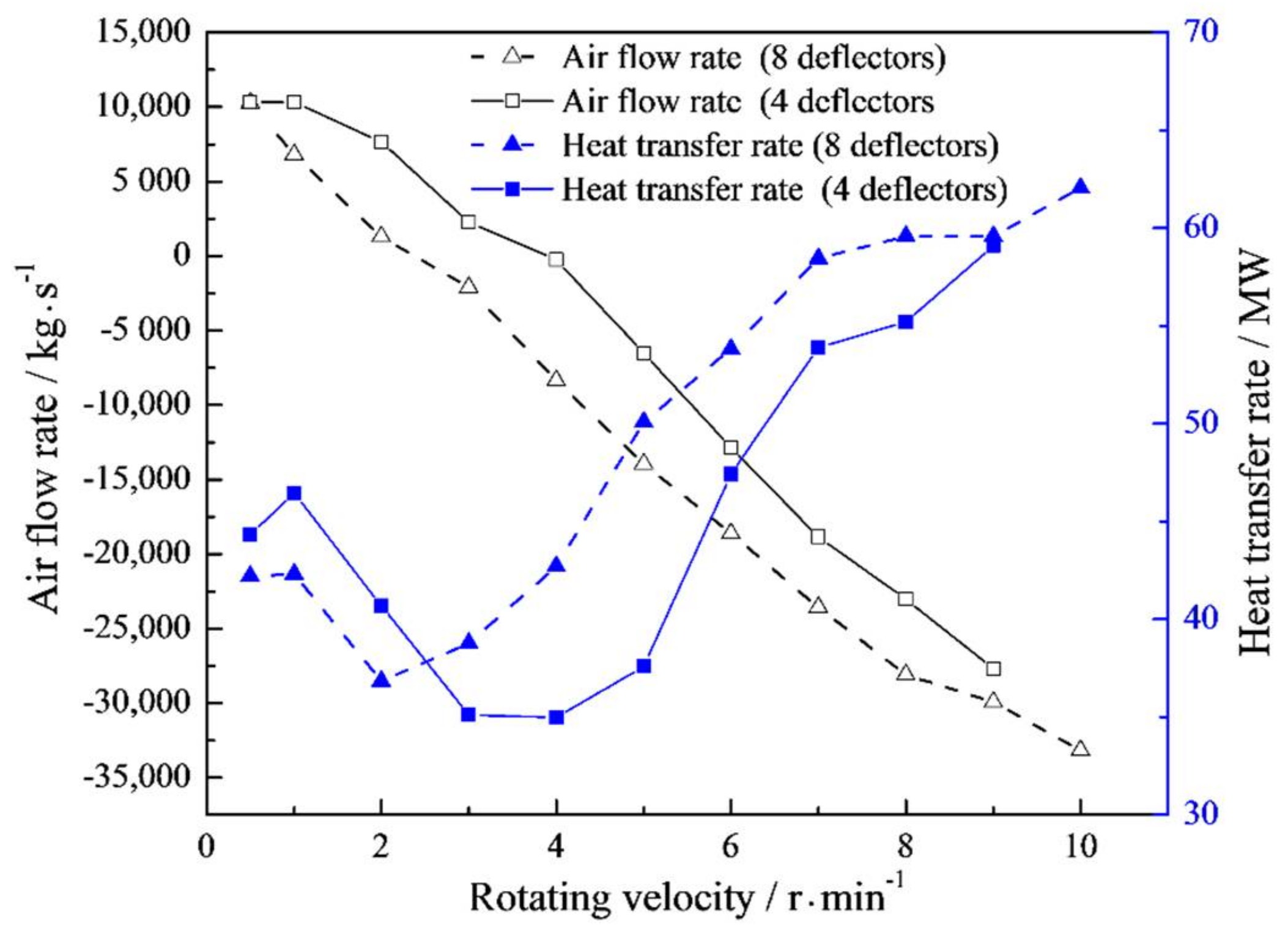
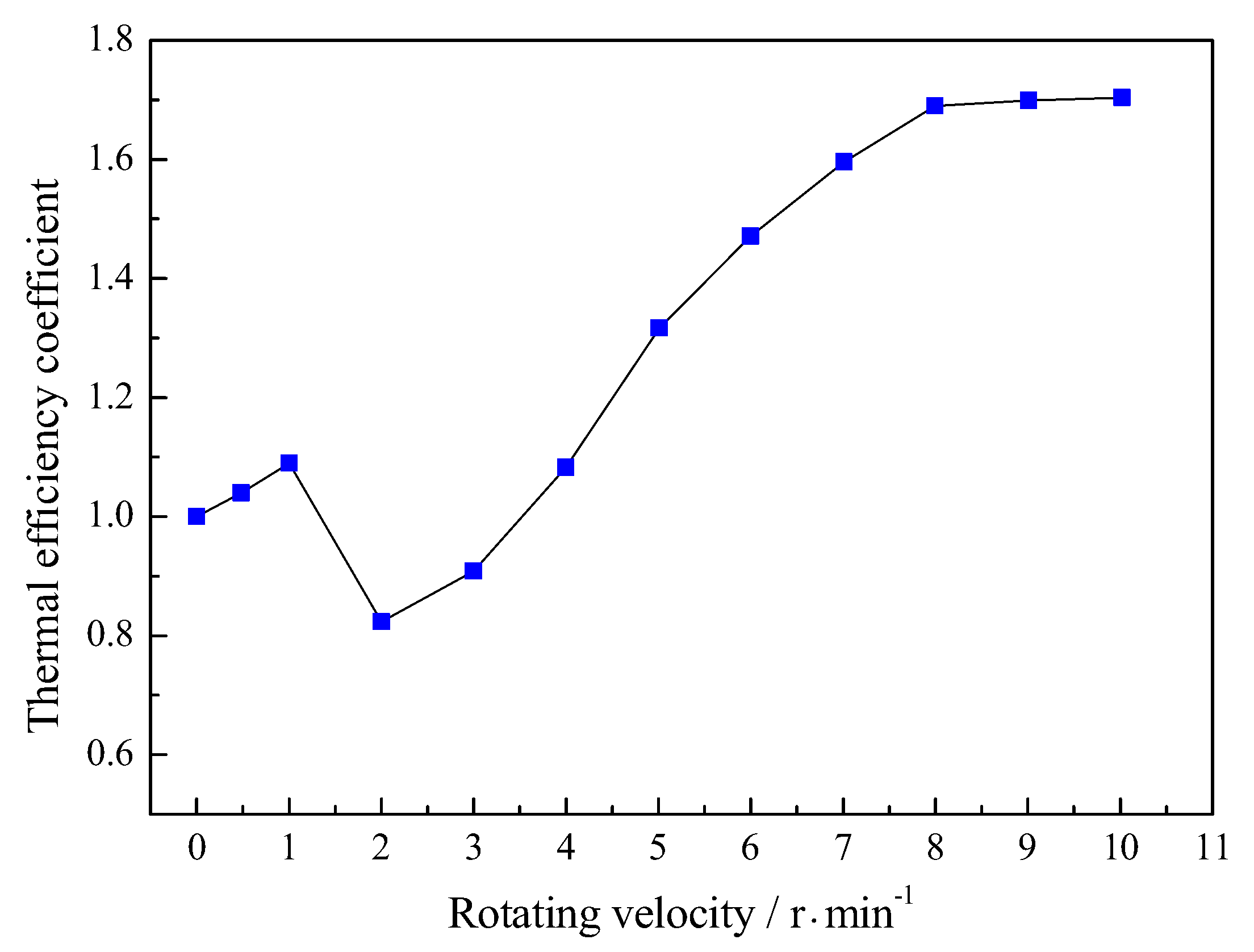
| Equation Name | |||
|---|---|---|---|
| Continuous | 1 | - | - |
| X-momentum | | ||
| Y-momentum | |||
| Z-momentum | |||
| Turbulent kinetic energy | |||
| Turbulence dissipation rate | |||
| Energy equation |
© 2018 by the authors. Licensee MDPI, Basel, Switzerland. This article is an open access article distributed under the terms and conditions of the Creative Commons Attribution (CC BY) license (http://creativecommons.org/licenses/by/4.0/).
Share and Cite
Du, X.; Han, D.; Zhu, Q. Heat Transfer Enhancement of the Air-Cooling Tower with Rotating Wind Deflectors under Crosswind Conditions. Appl. Sci. 2018, 8, 544. https://doi.org/10.3390/app8040544
Du X, Han D, Zhu Q. Heat Transfer Enhancement of the Air-Cooling Tower with Rotating Wind Deflectors under Crosswind Conditions. Applied Sciences. 2018; 8(4):544. https://doi.org/10.3390/app8040544
Chicago/Turabian StyleDu, Xueping, Dongtai Han, and Qiangmin Zhu. 2018. "Heat Transfer Enhancement of the Air-Cooling Tower with Rotating Wind Deflectors under Crosswind Conditions" Applied Sciences 8, no. 4: 544. https://doi.org/10.3390/app8040544
APA StyleDu, X., Han, D., & Zhu, Q. (2018). Heat Transfer Enhancement of the Air-Cooling Tower with Rotating Wind Deflectors under Crosswind Conditions. Applied Sciences, 8(4), 544. https://doi.org/10.3390/app8040544





